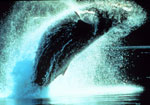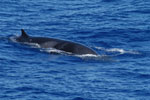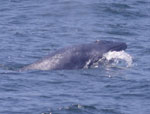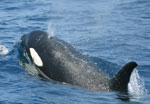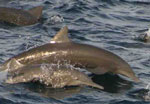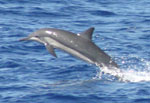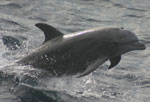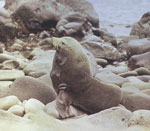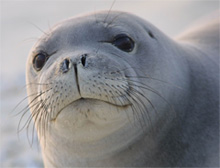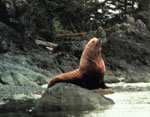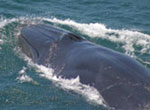FAQs - Marine Mammal Permits for Directed Take
Applying for a Permit | Application Processing | Permit Conditions | Photography | Public Display | Miscellaneous
Applying for a Permit
Why do I need to apply for a permit?
Under the Marine Mammal Protection Act of 1972 (MMPA) and the Endangered Species Act of 1973 (ESA) NOAA Fisheries has responsibility for the management of all cetaceans and pinnipeds (except walruses) in the U.S. and its territorial waters. Fur seals are also managed under the Fur Seal Act of 1966 (FSA) [pdf] [61 KB]. Therefore, any person, including citizens of foreign countries, who wants to "take", "import", or export any species of cetacean or pinniped under the jurisdiction of NOAA Fisheries, or any parts or products thereof, must obtain a permit from NOAA Fisheries.
Take of walruses, polar bears, sea otters, and manatees is also subject to regulations under the MMPA and ESA and also requires a permit. However, these species are under the jurisdiction of the U.S. Fish and Wildlife Service (USFWS). Contact the USFWS for details on how to apply for USFWS permits to work with these species. For work on a combination of marine mammals under the jurisdiction of both NOAA Fisheries and USFWS, contact the agency responsible for the largest number of species involved in the proposed activity.
Does a U.S. citizen need a permit under the MMPA to "take" or collect specimens in a foreign country?
No, a U.S. permit is not required for activities conducted by a U.S. citizen on land or in the territorial waters of another nation, unless the marine mammals or marine mammal parts are to be imported into the U.S. However, an MMPA permit is required for any "takes" by a U.S. citizen on the "high seas," i.e., international waters.
Where can I get a permit application and instructions?
The application and instructions for applying for a
are located on our web site or may be obtained by calling the Permits, Conservation and Education Division at 301-713-2289.
^ top
Application Processing
How long does it take to process my application for a permit?
NOAA Fisheries tries to process all applications in a timely manner. All applicants are urged to follow the application directions carefully and provide complete and specific information. Applicants should submit their application at least 6 months in advance of the intended research date for non-ESA listed species. For activities with ESA-listed species, applicants should submit their applications at least one year in advance. If the Permits, Conservation and Education Division does not need to contact you for further information, processing of an application for non-ESA listed marine mammals typically takes 120 days from the time it is received, including a required 30-day public comment period. Incomplete applications cannot be processed and will be returned.
Note that if your application directly involves a threatened or endangered species, or may indirectly affect a species listed under the ESA, additional environmental analyses are required including initiation of a section 7 consultation and preparation of a "biological opinion". These analyses require additional processing time. Applicants are encouraged to submit a complete application at least one year prior to the proposed initiation of any research on ESA-listed species.
Check the links below for ESA-listed species under the jurisdiction of NOAA Fisheries and USFWS.
Who reviews my application?
When your application is received, it is reviewed for completeness by a team of permit analysts. Complete applications are then distributed to other appropriate NOAA Fisheries scientists, the Marine Mammal Commission, other appropriate Federal agencies, and NOAA Fisheries Office of Law Enforcement. The application may also be sent to appropriate independent experts. In addition, a notice of the request is published in the Federal Register for a mandatory 30-day public comment period.
Will my application and permit be available to the public?
Yes. The regulations require that a Notice of Receipt or Issuance is published in the Federal Register for all permit applications and issued permits, respectively. Publication of the Notice of Receipt initiates a 30-day public comment period during which time anyone can obtain a copy of your application by contacting the Office. In addition, some applications and permits may be posted on the Office of Protected Resources web site. Further, anyone can, at any time following publication of Federal Register notices, request a copy of your application, permit, or related documents such as permit related correspondence.
Why do I have to indicate in my permit application when and where I anticipate publication of the results of my study?
To issue a permit for scientific research or enhancement, it must be demonstrated that the activity will further a "bona fide" scientific or enhancement purpose. By definition under the MMPA, bona fide research must be likely to be accepted for publication in a refereed scientific journal. It is also a requirement of the regulations supporting the ESA, and therefore a condition of your permit, that research results be published or otherwise made available to the scientific community in a reasonable time period. [50 CFR § 216.41(c)(ii)]
^ top
Permit Conditions
Why do I have to submit annual and final reports?
The Permits, Conservation and Education Division is responsible for oversight and coordination of all research and enhancement activities on marine mammals under the jurisdiction of the NOAA Fisheries. Reports are used to evaluate and track the effects of permitted activities, including cumulative effects, on the species. These reports are often the only way to acquire such information in a timely manner given the frequently long lag times between conducting of the research and publication of results. All permit holders are required to submit annual, final, and special reports as specified in the permit. [50 CFR § 216.38]
What sort of activities does a permit cover?
Under the statutes and implementing regulations of the ESA and MMPA, NOAA Fisheries may issue permits for the "taking", "importing", and exporting of marine mammals (including any "parts", products, specimens, or live animals), including threatened and endangered species, for scientific purposes or to enhance the propagation or survival of such species (50 CFR Parts 216 and 222-227). NOAA Fisheries may also issue permits for the taking, import, or export of non-ESA listed marine mammals for the purposes of public display, or for commercial or educational photography (50 CFR Part 216).
Permits authorize activities as described in your application except as modified by permit conditions. Permits cannot authorize activities, no matter how minor, if they were not specifically requested in the application.
When you receive your permit, please read every section, including any attachments. If you do not understand any part of your permit, please contact the Permits, Conservation and Education Division for clarification. NOAA Fisheries is the sole arbiter of whether a given activity is within the scope of the Permit. Failure to verify, where NOAA Fisheries subsequently determines the activity was outside the scope of the permit, may result in suspension or revocation of the permit and/or enforcement actions.
What if I want to change the experimental protocol after my permit has been issued?
Your permit authorizes you to conduct only those actions specifically stated; anything not expressly granted in your permit is not allowed. However, you may request an amendment to your permit by submitting a detailed proposal describing the purpose and nature of the amendment. Your request should also include any information not previously submitted as part of the original permit but necessary to determine whether the proposed amendment satisfies all issuance criteria (50 CFR § 216.39). Permit changes are classified as either major or minor amendments.
Major amendments include changes to:
- the number and species of marine mammals authorized to be taken, imported/exported, or otherwise affected;
- the manner in which these marine mammals may be taken, imported/exported, or otherwise affected if the proposed change may result in an increased level of take or risk of adverse impact;
- the location(s) in which the marine mammals may be taken, from which they may be imported, and to which they may be exported; and
- the duration of the permit, if the proposed extension would extend the duration of the permit more than 12 months beyond that established in the original permit.
Major amendments will be subject to all the same provisions governing review and decision, including publication in the Federal Register and a 30-day public comment period, as with the original application. If the amendment request involves an endangered species, a section 7 consultation may also be required or reinitiated.
Minor amendments are any requests to amend the permit that do not constitute a major amendment. Applications for minor amendments are not subject to publication in the Federal Register for public review or Marine Mammal Commission review. However, they must still comply with all permit-related statutes and regulations and a notice of issuance of the minor amendment will be published in the Federal Register within 10 days from the date of approval.
How does the number of "takes per animal" differ from the total number of takes?
The number of "takes per animal" refers to the number of times an individual animal is "harassed", hunted, captured, or collected. The "total number of takes" refers to the number of individual animals harassed, hunted, captured, killed or collected. For example, Whale City submits an application to NOAA Fisheries to conduct biopsy sampling on sperm whales for the purpose of contaminant analysis. Their study design requires a spring and fall biopsy sample from each of 30 different individuals. Therefore, they request a total number of takes equal to 30 sperm whales and the number of takes per whale equal to 2.
Who's who on my permit and who can participate in the actions listed under my permit?
The "Applicant"/"Permit Holder" is the person, institution, or agency ultimately responsible for all activities of any individual who is operating under the authority of the permit. A permit can have only one individual or institution designated as the Permit Holder. Permits are non-transferable and cannot be assigned to any other person, institution, or agency.
For scientific research and enhancement permits the "principal investigator (PI)" is the individual primarily responsible for the taking, import, or export, and any related activities conducted under the permit. "Co-Investigators (CI)" are the on-site representatives of the PI who conduct or directly supervise the conduct of the taking, import, and export activities authorized under the permit. "Research Assistants (RA)" are any individuals, working under the direct and on-site supervision of the PI and/or CI, who are not qualified to be PI or CI.
Individuals listed on the permit as PI and CI must possess qualifications commensurate with the procedures and activities they are authorized under the permit to conduct, including possessing any applicable licenses required by state or Federal law to conduct such activities. Similarly, all RAs must be duly qualified to perform permit authorized activities and must be under the direct on-site supervision of a person with such qualifications. Note that only veterinarians or other highly trained individuals approved by NOAA Fisheries may perform "intrusive research" procedures on animals in the wild.
Can my graduate students work under my permit, or do field work without me?
If they possess appropriate qualifications, graduate students may be designated by NOAA Fisheries as a "CI" to conduct permit authorized activities in the absence of the "PI". No person, including graduate students, who is not listed as a CI on the permit may conduct activities in the field in the absence of the PI.
How do I add or remove personnel from my permit?
To designate a "Co-investigator (CI)" to take, import or export marine mammals or marine mammal specimens authorized in the permit, the "Holder" or "Principal Investigator (PI)" must submit a letter to the Chief, Permits, Conservation and Education Division, Office of Protected Resources. The letter must include a description of the duty(ies) to be performed and the relevant qualifications of the individual. Approval by NOAA Fisheries to add a CI is based on the individual's qualifications to perform the requested activity(ies). Similarly, if the Holder is an institution, they can request a change of PI by submitting a written request. The Holder or PI can also request additional RAs by the same procedure. Requests to remove a CI or RA must also be submitted in writing.
Do I have to carry my permit with me into the field?
Yes. The permit holder or "PI"/"CI" must have a copy of the permit when engaged in a permitted activity, when the marine mammal is in transit incidental to such activity, and whenever marine mammals or "marine mammal parts" are in the possession of the permit holder or PI/CI. A copy of the permit must also be affixed to any container, package, enclosure, or other means of containment in which the marine mammals or marine mammal parts are placed for purposes of transit, supervision, or care. For marine mammal parts in storage, a copy of the permit must be kept on file in the storage facility. [50 CFR § 216.35(j)]
What is the maximum duration of a permit?
The maximum period for any marine mammal or endangered species permit is five consecutive years from the effective date.
Can I get an extension of my permit after it has expired?
No, but any time before the expiration date on your permit you can apply for a minor amendment to extend your permit for up to 12 months beyond that established in the original permit [50 CFR § 216.35(b)].
My research has ended but the Permit is still valid. Can I give it to someone else?
No. Scientific research permits are not transferable or assignable to any other person, and a permit holder/PI cannot require direct or indirect compensation from another person in return for such person to conduct the taking authorized under the permit. [50 CFR § 216.35(i)] You should notify the Permits, Conservation and Education Division when a permit is no longer needed so it can be amended to terminate early.
^ top
Photography
Can I sell photographs or footage taken under my scientific research permit?
The "Permit Holder" and all researchers working under a NOAA Fisheries permit must obtain prior approval from the NOAA Fisheries Permits, Conservation and Education Division for the non-research related use of photographs, video and/or film that were taken to achieve the research objectives. Any footage or film approved for use must include a credit, acknowledgment, or caption indicating that the research was conducted under a permit issued by NOAA Fisheries under the authority of the MMPA and/or ESA.
What if a commercial film crew wants to document my research? Do they need a permit?
A film crew may accompany the "PI"/"CI" on a research site under certain circumstances. Two options are available:
- the film crew can apply for a separate commercial or educational photography permit and they would be restricted to activities classified as "Level B harassment" on non-endangered marine mammals, only, or
- the film crew may be authorized to accompany the research team working under the Holder's existing marine mammal permit. Their presence cannot influence the conduct of research activities in any manner.
^ top
Public Display
Do I need a permit to display marine mammals for the public?
No. Public Display of marine mammals is based on three criteria. Facilities holding and maintaining marine mammals for the purposes of public display must:
- Maintain facilities that are open to the public on a regularly scheduled basis with access that is not limited or restricted other than by charging an admission fee;
- Offer a program of education or conservation that is based on professionally recognized standards of the public display community. [Standards developed and endorsed by the American Zoo and Aquarium Association
 and the Alliance of Marine Mammal Parks and Aquariums and the Alliance of Marine Mammal Parks and Aquariums  were published in the Federal Register on October 6, 1994 (59 FR 50900)]; and were published in the Federal Register on October 6, 1994 (59 FR 50900)]; and
- Be registered or hold an exhibitors license, issued by the USDA APHIS, under the "Animal Welfare Act (AWA)" (7 U.S.C. 2131
 et seq.) et seq.)
Do I need a permit to export a marine mammal for public display?
No. Permits are not required for the exportation of marine mammals from U.S. public display facilities for display in a foreign zoo or aquarium. However, the receiving Holder/Facility ("person" who will have custody of the captive marine mammal) must meet similar standards to the MMPA, as follows:
- Maintain facilities open to the public on a regularly scheduled basis with access that is not limited or restricted other than by charging an admission fee;
- Offer a program of education or conservation that is comparable to U.S. standards
- Meet comparable standards of the "AWA" with concurrence from "APHIS"; and
- The appropriate agency of the foreign government must submit a statement certifying that:
- the application is accurate;
- the laws and regulations of the government involved have equivalent provisions to the MMPA and "AWA", and that such laws will be enforced; and
- the government will provide comity (a rule of courtesy by which one government honors decisions made by another government) to requests made by NOAA Fisheries.
^ top
Miscellaneous
Do I need a permit to retain a stranded marine mammal for the purposes of public display?
A permit is required to hold a releasable marine mammal in captivity for any purpose, including public display. The MMPA gives the Secretary of Commerce authority to enter into agreements with persons to rescue or import "stranded" marine mammals for the purpose of "rehabilitation" (Section 109(h)). During the course of rehabilitation, a marine mammal may be determined to be releasable (return to the wild) or non-releasable (necessary to retain in captivity) according to the criteria set forth in 50 CFR § 216.27. Provided that authorization is granted by NOAA Fisheries, a marine mammal that has been classified as non-releasable may be held for the purposes of public display in accordance with the public display criteria listed above.
What is the General Authorization?
On October 3, 1994, Interim Final Regulations establishing a General Authorization (GA) for Scientific Research on non-listed marine mammal species (species not listed as threatened or endangered under the ESA) that involves only "Level B Harassment" were published in the Federal Register (59 FR 50372). Researchers must submit a Letter of Intent, which will be reviewed by the Permits, Conservation and Education Division. If it is determined that the proposed research is "bona fide" and that the impacts of the activities are limited to Level B Harassment only, and no ESA listed species will be affected, the researcher will be granted a letter of confirmation stating that they are covered under the GA. Instructions for submitting a Letter of Intent under the GA are on the web site or may be obtained by calling the Permits, Conservation and Education Division of the Office of Protected Resources (301-713-2289).
Who can euthanize a marine mammal in severe distress?
Section 109(h)(1) of the MMPA authorizes qualified Marine Mammal Stranding Network members (and government employees) to humanely euthanize non-endangered marine mammals in severe distress. Endangered marine mammals can only be euthanized by qualified stranding network members who have special permission granted directly from NOAA Fisheries or USFWS.
^ top
|
